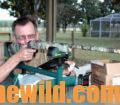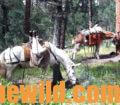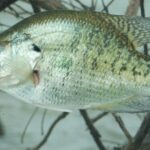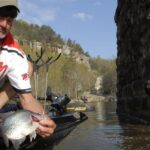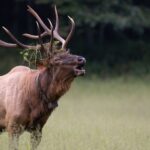Editor’s Note: 54-year-old Billy Bishop grew up in the White Mountains of Surprise, Arizona, and today lives in Buckeye, Arizona. He’s been an elk and mule deer guide since he was 19 and currently operates Blue Wilderness Guide Services (https://www.gohunt.com/outfitter/blue-wilderness-guide-services). His dad, Bill Bishop, was a construction worker during the spring and summer. When the weather wasn’t good, Billy and his dad trapped when fur was still selling at good prices. Once fur prices plummeted, Bill Bishop began to guide to elk and mule deer, and his son Billy became his first employee. The Bishop family has trapped, hunted and guided together most of their lives. Both archery enthusiasts, Bill and Billy have used their bows to take elk, mule deer and Coues deer when not trapping or guiding. “Over the years, I’ve called in more than 30 serious bull elk that my clients and I have harvested,” Billy Bishop, the son, reports. Billy Bishop hunts in the extreme backcountry and most often packs into wilderness areas on horseback, setting-up spike camps from where he and his clients can hunt during the season. Billy prefers to hunt what he calls “The Old Country,” areas where many older Bull elk go to retire and dodge hunters. The terrain is very brushy there and, in many instances, very steep in these regions. He’s not hunting private lands but rather Bureau of Land Management (BLM) lands (https://www.blm.gov/arizona), which is for the most part, public-hunting lands. To learn more about Billy Bishop you also can visit his Facebook page at https://www.facebook.com/BlueWildernessGuideServices/.
Over the years, not only have I guided for myself to elk and mule deer, but I’ve often guided for other outfitters. This hunt for the vanishing bull elk took place when I was guiding for an outfitter who had a nice lodge for his base camp. Back then, we were able to use quads (four-wheelers) to go as far as we could into the wilderness. Afterwards, we would hike 4 miles from where we left our 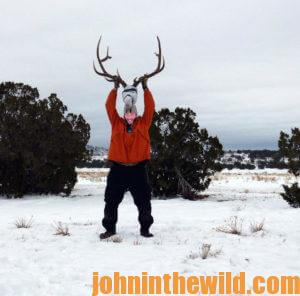 four-wheelers into what appeared to be rolling-hills country with plenty of junipers. One time I saw a bull elk feeding toward us, and I asked my client if that was the bull he’d like to take. He replied with a, “Yes.” When we reached a good spot, my shooter executed the shot with a 7mm Mag and took the bull that was about 400-yards away. However, once the bull took the bullet, he started running toward us but suddenly vanished.
four-wheelers into what appeared to be rolling-hills country with plenty of junipers. One time I saw a bull elk feeding toward us, and I asked my client if that was the bull he’d like to take. He replied with a, “Yes.” When we reached a good spot, my shooter executed the shot with a 7mm Mag and took the bull that was about 400-yards away. However, once the bull took the bullet, he started running toward us but suddenly vanished.
We did our high fives, congratulated each other and assumed that all we had to do was walk to where the bull should be down and call in to the base camp for help getting the bull caped, quartered and butchered to carry back out to our four-wheelers. “Let’s go look at your bull,” I told my hunter. We only walked a short distance until stopping on the edge of a cliff. We looked down into a very-deep canyon that we’d never noticed was between us and the vanishing bull. After shooting the bull, we spent 4 hours trying to get around the canyon to where the bull had vanished. When we found him, I used a radio to call the outfitter back at base camp and asked him to bring help with him.
Evidently, when the bull vanished, he’d fallen off the cliff on the other side of the canyon and now was lying on one of the steepest edges. I explained to my hunter, “You gotta tie this bull to the 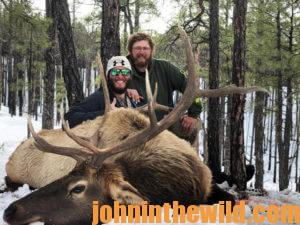 trees by his front legs, hind legs, head and antlers. If we don’t, when we start field dressing and skinning him out to try and quarter him, that bull is gonna slide all the way down the canyon. Then we’ll really have a terrible time trying to get him back to base camp.” Luckily, I always keep plenty of rope in my backpack, but I don’t believe that I ever have had to use my rope to tie the legs and head of a downed bull elk to prevent him from sliding down a canyon.
trees by his front legs, hind legs, head and antlers. If we don’t, when we start field dressing and skinning him out to try and quarter him, that bull is gonna slide all the way down the canyon. Then we’ll really have a terrible time trying to get him back to base camp.” Luckily, I always keep plenty of rope in my backpack, but I don’t believe that I ever have had to use my rope to tie the legs and head of a downed bull elk to prevent him from sliding down a canyon.
“The first thing we have to figure out is how to get this elk off this cliff before we ever start cutting on him,” the outfitter told us. So, we decided to leave the hide on the hindquarters and slide them down the cliff to the bottom of the canyon on the hide. We field dressed the deer so no blood was on the hindquarters, which worked so well that we decided to use the elk hide to wrap all of the meat. I carried the antlers in my backpack. Once we got the head and all the people who came with us down to the bottom of the canyon, we left the elk’s head there. Since all of the people helping us were wearing cargo-carrying frame packs, we made the long journey up the creek and toward the bottom of the canyon where we slid the meat. By the time we got all the meat loaded on the frame packs and back down the creek to where I’d left the antlers, we climbed up the mountain where my hunter had taken his shot and carried the meat and antlers all the way back to the quads. We finally arrived back at base camp at 9:30 pm that night. With all that we endured, that hunt was one of the most-memorable hunts I ever could remember.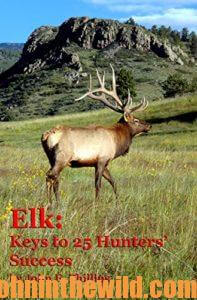
To learn more about hunting elk successfully, check out John E. Phillips’ book, “Elk: Keys to 25 Hunters’ Success,” available in Kindle, print and Audible versions at https://amzn.to/2IDszQk.
Tomorrow: Billy Bishop Prefers Horseback Packing Trips for Elk

